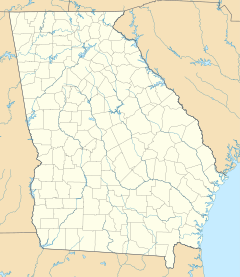St. Simons Island Light

Lighthouse and keeper's house
|
|
|
Georgia
|
|
| Location | 600 Beachview Dr., Saint Simons Island, Georgia |
|---|---|
| Coordinates | 31°08′03″N 81°23′37″W / 31.13411°N 81.39358°WCoordinates: 31°08′03″N 81°23′37″W / 31.13411°N 81.39358°W |
| Year first constructed | 1810 |
| Year first lit | 1872 |
| Foundation | Tabby |
| Construction | Iron and brick |
| Tower shape | Frustum of a cone |
| Markings / pattern | White tower attached to a two-story brick dwelling with red roof |
| Height | 104 feet (32 m) |
| Original lens | Third-order Fresnel lens |
| Characteristic | continuous white light with a more intense flash every 60 s |
| Admiralty number | J2842 |
| ARLHS number | USA-805 |
| USCG number |
3-0520 |
|
St. Simons Lighthouse and Lighthouse Keepers' Building
|
|
| Area | 3.6 acres (1.5 ha) |
| Built | 1889 |
| Architect | Poe, Bvt. Gen. O.M.; Charles B. Cluskey |
| Architectural style | Gothic, Other, Eclectic |
| NRHP Reference # | 72000386 |
| Added to NRHP | April 13, 1972 |
| Heritage | place listed on the National Register of Historic Places |
|
[]
|
|
3-0520
The St. Simons Island Light is a lighthouse on the southern tip of St. Simons Island, Georgia, United States. It guides ships into St. Simons Sound and warns of the many sandbars in the area.
The original St. Simons Island lighthouse, which was built in 1810, was a 75-foot-tall (23 m) early federal octagonal lighthouse topped by a 10-foot (3.0 m) oil-burning lamp. During the American Civil War, U.S. military forces employed a Naval blockade of the coast. An invasion by Union troops in 1862 forced Confederate soldiers to abandon the area. The retreating troops destroyed the lighthouse to prevent it from being an aid to the navigation of Union warships.
The U.S. government constructed a new lighthouse to replace the original, building it to the west of the original's location. It is a 104-foot (32 m) brick structure completed in 1872 and was outfitted with a third-order, biconvex Fresnel lens. The lens is one of 70 such lenses that remain operational in the United States. Sixteen of those are in use on the Great Lakes, of which eight are in Michigan. The rotating lens projects four beams of light, with one strong flash every 60 seconds. A cast iron spiral stairway with 129 steps leads to the galley (or watch/service room). In 1876, the lighthouse was overhauled.
The Lighthouse is reputed to be haunted by the ghost of lightkeeper Frederick Osborne, who was killed in a duel with assistant keeper John Stephens in early March 1880. One account had Osborne, apparently a chronic faultfinder, making an inappropriate remark to Stephens's wife, the other had Stephens making unwanted advances on Osborne's wife. At any rate, standing 98 feet apart, Osborne had a pistol and Stephen a shotgun loaded with buckshot. Stephen fatally wounded Osborne and was later acquitted of any charges. Stephens later reported hearing footsteps ascending and descending the tower steps and blamed it on Osborne's ghost. There's an account of keeper Svendsen's family dog Jinx being constantly harassed by the ghost. Multiple witnesses have reporting hearing the sounds on the steps, including Coast Guardsmen while doing routine maintenance of the light mechanism. The belief is the fastidious Fred Osborne is coming back to check and make sure that the light is properly cared for. On November 30, 2013 a paranormal investigation group called LDLParanormal, claims to have identified electronic voice phenomenon (EVP) and recorded them on video with the alleged actual voice of Frederick Osborne. The Video was posted December 3, 2013 and also indicates evidence about Lisa Register who allegedly committed suicide August 19, 1999 by jumping from the top of the lighthouse. On December 26, 2015 LDLParanormal again investigated the lighthouse this time from the top of the observation deck on the east side and again documented on video, voices that indicated that Osborne may have been shot with a pistol One of the EVP's recorded indicates in a Class A EVP the name "Carl" and indications are that this refers to Carl Olaf Svendsen who ran the light house in 1910
...
Wikipedia

